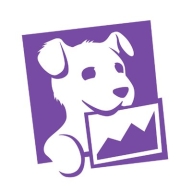

Datadog and Chronosphere compete in cloud monitoring solutions. Datadog appears to have the upper hand with broader feature availability and robust integration options.
Features: Datadog offers comprehensive monitoring, customizable dashboards, and extensive third-party integrations enabling easy monitoring consolidation across services. Chronosphere emphasizes high scalability, efficient data ingestion, and cost efficiency, reducing latency for large-scale data handling.
Ease of Deployment and Customer Service: Datadog has streamlined deployment, extensive documentation, and support services making setup straightforward for cloud environments. Chronosphere meets enterprise needs with tailored deployment options and strong support for complex deployments.
Pricing and ROI: Datadog's tiered pricing structure is perceived as strong value despite higher upfront costs due to feature depth. Chronosphere offers competitive pricing emphasizing low-cost scalability, resulting in favorable ROI for managing vast data volumes.
| Product | Market Share (%) |
|---|---|
| Datadog | 6.0% |
| Chronosphere | 0.6% |
| Other | 93.4% |


| Company Size | Count |
|---|---|
| Small Business | 80 |
| Midsize Enterprise | 46 |
| Large Enterprise | 98 |
Chronosphere provides a robust platform for managing and monitoring cloud-native applications with features like real-time observability, incident management, and capacity planning. It offers scalable, detailed observability across complex systems, an intuitive interface, and cost-efficient resource management. Users report enhanced productivity, improved collaboration, and better decision-making, bolstering operational capabilities and organizational growth.
Datadog integrates extensive monitoring solutions with features like customizable dashboards and real-time alerting, supporting efficient system management. Its seamless integration capabilities with tools like AWS and Slack make it a critical part of cloud infrastructure monitoring.
Datadog offers centralized logging and monitoring, making troubleshooting fast and efficient. It facilitates performance tracking in cloud environments such as AWS and Azure, utilizing tools like EC2 and APM for service management. Custom metrics and alerts improve the ability to respond to issues swiftly, while real-time tools enhance system responsiveness. However, users express the need for improved query performance, a more intuitive UI, and increased integration capabilities. Concerns about the pricing model's complexity have led to calls for greater transparency and control, and additional advanced customization options are sought. Datadog's implementation requires attention to these aspects, with enhanced documentation and onboarding recommended to reduce the learning curve.
What are Datadog's Key Features?In industries like finance and technology, Datadog is implemented for its monitoring capabilities across cloud architectures. Its ability to aggregate logs and provide a unified view enhances reliability in environments demanding high performance. By leveraging real-time insights and integration with platforms like AWS and Azure, organizations in these sectors efficiently manage their cloud infrastructures, ensuring optimal performance and proactive issue resolution.
We monitor all Application Performance Monitoring (APM) and Observability reviews to prevent fraudulent reviews and keep review quality high. We do not post reviews by company employees or direct competitors. We validate each review for authenticity via cross-reference with LinkedIn, and personal follow-up with the reviewer when necessary.